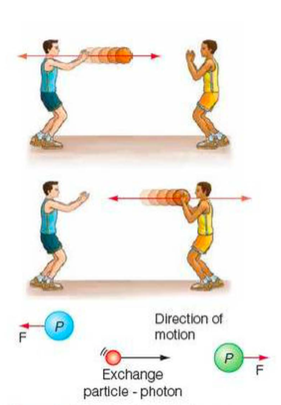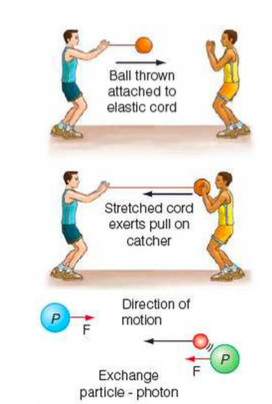Fundamental Forces
Introduction
⇒ Not only does the Standard Model describe the 12 fundamental particles, it also describes the four fundamental forces that allow the fundamental particles to interact with one another
- Note, when talking about forces on the quantum (i.e. small) scale, the word interaction and force mean the same thing
Exchange Particles
⇒ Exchange particles are 'virtual' particles involved in the interaction between two other particles via the four fundamental forces on the quantum scale
- These exchange particles are only created, emitted, absorbed, and destroyed between the particles that are interacting with one another
⇒ The fundamental forces and their exchange particles can be seen below:

Exchange Particles and Interaction
⇒ Two protons can interact (i.e. exert a force on one another) by exchanging 'virtual' photons (an exchange particle) through electromagnetic interaction
⇒ The photons are exchanged between the two protons in both directions for an extremely short amount of time (hence why they are 'virtual' photons)
⇒ The diagram below explains this: the two players are the protons and the ball being passed between them is the exchange particle (i.e. the photon). Momentum is exchanged between the players and the ball, and a force is produced

⇒ Although this explains well how the repulsive force between two particles with the same charge works (such as between protons), it does less well explaining how attractive forces work on the quantum scale
- Attractive forces include the strong, weak and gravitational forces, plus electromagnetic interaction between particles with opposite charges
⇒ The best way to visualise attractive forces on the quantum scale is to imagine that the balls (i.e. exhcange particle) being passed between the players (the two particles) above are attached to elastic chords. As the ball is caught, the elastic chord pulls the catcher back towards the thrower.
- To make this visualisation even better, imagine that the chord's effectiveness in pulling the catcher back decreases the further away the catcher gets to the thrower
- In other words, in the quantum world, the attractive forces between particles decreases the further away they get from each other

The Electromagnetic Force
⇒ On the quantum scale, electromagnetic interaction occurs between charged particles e.g. most commonly between electrons and protons
⇒ Although the exchange particle of electromagnetic interaction - the photon - acts over infinite distances, the strength of the force decreases with an inverse-square relationship to distance, 1⁄r2
- In other words, if the two particles move n times further away, the effect of the force gets n2 times weaker i.e. as the distance doubles, the force reduces by a factor of four

⇒ In eletromagnetic interaction the exchange particle (the photon) only exists throughout the time of the interaction itself, hence why they are called virtual particles
The Strong Nuclear Force
⇒ The Strong Nuclear Force acts between quarks and it is an extremely short range force (10-14 to 10-15m)
⇒ The Strong Nuclear Force's exchange particle is the gluon
⇒ It is an incredibly strong force (hence the name) - it is about 137 times stronger than the electromagnetic force
⇒ As it acts between quarks, it is responsible for holding protons and neutrons together. It is also the force that holds the nuclei together.
The Weak Force
⇒ The weak force is responsible for beta decay (β- and β+), electron capture, and electron-proton collision
- See our notes on Feynman Diagrams to find out more about electron capture and electron-proton collision
⇒ There are three exchange particles involved with the weak force: W+, W-, and Z0
⇒ The weak force is about 1 million times weaker than the strong force and acts at incredibly short distances (10-18 m)
Gravity
⇒ This fundamental force is responsible for the macroscopic (i.e. large-scale) behaviours of the universe
⇒ On the quantum scale, gravity is the weakest of the fundamental forces
⇒ How gravity works on the quantum scale is not well understood
⇒ The proposed name for the exchange particle is called the graviton, but because it has such a small force on the quantum scale it is nearly impossible to observe
Extra
⇒ Also see our notes on: